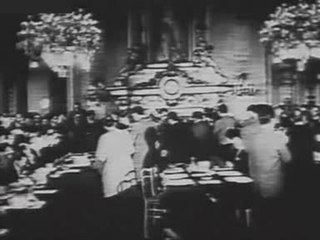
The Treaty on the Functioning of the European Union is one of two treaties forming the constitutional basis of the European Union (EU), the other being the Treaty on European Union.
The Treaty of Paris was signed on 18 April 1951 between France, West Germany, Italy and the three Benelux countries, establishing the European Coal and Steel Community (ECSC), which subsequently became part of the European Union. The treaty came into force on 23 July 1952 and expired on 23 July 2002, exactly fifty years after it came into effect.

The European Atomic Energy Community is an international organisation established by the Euratom Treaty on 25 March 1957 with the original purpose of creating a specialist market for nuclear power in Europe, by developing nuclear energy and distributing it to its member states while selling the surplus to non-member states. However, over the years its scope has been considerably increased to cover a large variety of areas associated with nuclear power and ionising radiation as diverse as safeguarding of nuclear materials, radiation protection and construction of the International Fusion Reactor ITER.

The European Communities (EC), sometimes referred to as the European Community, were three international organizations that were governed by the same set of institutions. These were the European Coal and Steel Community (ECSC), the European Atomic Energy Community, and the European Economic Community (EEC); the last of which was renamed the European Community (EC) in 1993 by the Maastricht Treaty, which formed the European Union.
The European Political Community (EPC) was proposed in 1952 as a combination of the existing European Coal and Steel Community (ECSC) and the proposed European Defence Community (EDC). A draft EPC treaty, as drawn up by the ECSC assembly, would have seen a directly elected assembly, a senate appointed by national parliaments and a supranational executive accountable to the parliament.

The Schuman Declaration is the statement made by the French foreign minister Robert Schuman on 9 May 1950. It proposed to place French and German production of coal and steel under one common High Authority. This organization would be open to participation of Western European countries. This cooperation was to be designed in such a way as to create common interests between European countries which would lead to gradual political integration, a condition for the pacification of relations between them: “Europe will not be made all at once, or according to a single plan. It will be built through concrete achievements which first create a de facto solidarity. The coming together of the nations of Europe requires the elimination of the age-old opposition of France and Germany”.

The Monnet Authority was the first High Authority of the European Coal and Steel Community (ECSC), between 1952 and 1955. Its president was Jean Monnet of France.

The Mayer Authority was the second High Authority of the European Coal and Steel Community (ECSC), between 1955 and 1958. Its president was René Mayer of France.

The Finet Authority was the third High Authority of the European Coal and Steel Community (ECSC), between 1958 and 1959. Its president was Paul Finet of Belgium.

The Del Bo Authority was the last High Authority of the European Coal and Steel Community (ECSC), between 1963 and 1967. Its president was Rinaldo Del Bo of Italy. Del Bo was briefly followed by Albert Coppé's interim Authority.

The period saw the first moves towards European unity as the first bodies began to be established in the aftermath of the Second World War. In 1951 the first community, the European Coal and Steel Community was established and moves on new communities quickly began. Early attempts at military and political unity failed, eventually leading to the Treaties of Rome in 1957.

This is a timeline of European Union history and its previous development.

The Messina Conference of 1955 was a meeting of the six member states of the European Coal and Steel Community (ECSC). The conference assessed the progress of the ECSC and, deciding that it was working well, proposed further European integration. This initiative led to the creation in 1957 of the European Economic Community and Euratom.

The Benelux memorandum of 1955 was a document drafted by the three Benelux countries on 18 May 1955 as a means to reviving European integration on the basis of a general common market.

The flag of the European Coal and Steel Community was a horizontal bicolour flag defaced with stars which represented the European Coal and Steel Community (ECSC) between 1958 until 2002 when the Community was merged into the European Union (EU). Prior to 1958 the ECSC did not have a flag, and no other flag has been used by a historical part of the European Union other than the flag of Europe.

The High Authority was the executive branch of the former European Coal and Steel Community (ECSC). It was created in 1951 and disbanded in 1967 when it was merged into the European Commission.

The Inner Six, or simply "the Six", were the six founding member states of the European Communities. They were in contrast to the outer seven who formed the European Free Trade Association rather than engage in supranational European integration. Five of the Outer Seven later joined the European Communities.

The Accession of the United Kingdom to the European Communities (EC) – the collective term for the European Coal and Steel Community (ECSC), the European Economic Community (EEC) and the European Atomic Energy Community (EAEC) – took effect on 1 January 1973. This followed ratification of the Accession treaty which was signed in Brussels on 22 January 1972 by the Conservative prime minister Edward Heath, who had pursued the UK's application to the EEC since the late 1950s. Denmark and Ireland also joined as part of the same expansion but Norway, who had signed the treaty, declined to ratify it and so it was amended to exclude that country. The ECSC and EEC would later be integrated into the European Union under the Maastricht and (subsequently) Lisbon treaties.

Léon Daum was a French mining engineer, company director and senior European administrator. He was a member of the High Authority of the European Coal and Steel Community from 1952 to 1959
This page is based on this
Wikipedia article Text is available under the
CC BY-SA 4.0 license; additional terms may apply.
Images, videos and audio are available under their respective licenses.







